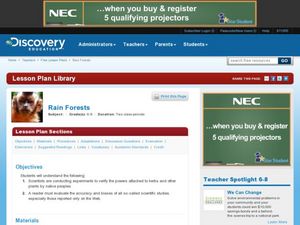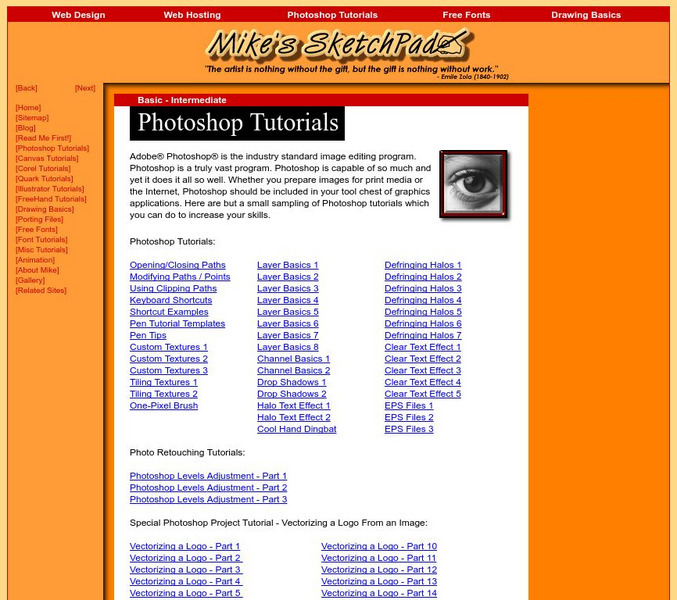Curated OER
EGG MAZE: COUNTING BY TWOS, THREES AND FIVES
Students successfully count by twos, threes and fives, using pictures of eggs and poultry as points of interest. They orally review the types of counting (twos, threes, or fives). Students are introduced the idea of a dozen eggs.
Curated OER
The History of Rock and Roll
Seventh graders examine how the different layers of rock show the history of the Earths surface. In this rock lesson students divide into groups and complete an activity using clay.
Curated OER
Layers of the Atmosphere
Students analyze how the atmosphere can be divided into layers based on temperature changes. In this layers of the atmosphere lesson students plot data points and determine where the layers begin and end based on their reading material.
Curated OER
Earth's Layers
Students identify the interior layers of the Earth and analyze a diagram. In this Earth's layers lesson students create a model of the Earth's interior.
Curated OER
Clouds
In this clouds worksheet, students respond to 3 different sets of questions related to the 3 types of clouds illustrated. First, they label each type of cloud illustrated in the pictures. Then, students draw a line from each description...
Curated OER
Structure of the Earth
Sixth graders examine the layers of the Earth and the changes that take place on a daily basis. They look at the layers of a boiled egg to relate them to the layers of the Earth.
Curated OER
Layers Upon Layers - Lesson Plan
Young scholars study rock layers and the sequence of events that occur when a canyon forms. In this sedimentary lesson plan students complete a lab while in groups and discuss what happens.
Curated OER
Who Has Denser Fur?
In this mathematics worksheet, learners identify and solve who has the denser fur, either the Sumatran tiger or the sea otter. They calculate the number of hairs for each per inch or per meters and compare them.
Curated OER
Layering of Water
Students examine what happens when different types of water meet. In groups, they participate in an activity in which they combine different percentages of salt, fresh and brackish water and record their observations. They let the...
Curated OER
Stratigraphy -- Layers of Time in the Earth
Students are introduced to the process of stratification. Using the internet, they read about the Richard Beene archeological site near San Antonio. Using a map, they color code the different layers present at this site and answer...
Curated OER
Who am I? Bookmaking
Students explore the process of bookmaking that has its origins from many different international cultures. The multicultural symbolism represented by the medium is utilized by students to expres their identity.
Curated OER
Understanding the Layers of the Earth
Fourth graders explore the three layers of the Earth describing the composition, thickness, and temperature of each layer. Layers are compared and contrasted and data unearthed placed into graphic organizers.
Curated OER
Rain Forests
Students watch a PowerPoint presentation about the layers of the rainforest. They create a paper rainforest in the classroom. They take notes from the presentation and write a paragraph to include in a layer book. They create a...
PBS
Pbs Learning Media: Above the Clouds: Telescopes on Mauna Kea
This video segment adapted from First Light explains why the highest peak in the Pacific, Mauna Kea, is an ideal site for astronomical observations. Featured are new telescope technologies that allow astronomers to explore the universe...
Science Buddies
Science Buddies: Sorting Out Sedimentation
Sedimentary rock forms in layers that are deposited one after the other over long periods of time. Oftentimes, sedimentary rock contains fossils and other debris that are deposited within the layers. Use this experiment to investigate...
PBS
Pbs: Scientific American Frontiers: Earth on the Move
The interactive resource examines the plate tectonics, magnetic reversals, and continental drift of the Earth. An animation of the Earth's continental drift over the last 750 million years is included.
National Weather Service
National Weather Service: Jet Stream: The Atmosphere
Learn about the atmosphere, it's make-up, the layers, the hydrologic cycle and more. The National Weather Service presents this site, including learning lessons and review questions.
American Geosciences Institute
American Geosciences Institute: Earth Science Week: What's Down There?
Students build a model to learn about the cycle of erosion and deposition by water and wind which deposits layer upon layer of rock, soil, and organic material to the surface.
Annenberg Foundation
Annenberg Learner: Interactives: Rock Cycle: How Rocks Change
Find out how rocks and rock layers change with erosion and weathering.
Center for Educational Technologies
Cotf: Plate Tectonics
Plate Tectonics provides geology with a comprehensive theory that explains how the Earth works.
Other
Photoshop Tutorials
Here is another great site to gain more insight into using Photoshop by using his tutorials.
ClassFlow
Class Flow: Soil
[Free Registration/Login Required] This flipchart contains a pre-test using the Activotes. It is a third grade study of the three main types of soil as well as the layers of soil. Graphic organizers and hands-on experiments are integrated.
American Geosciences Institute
American Geosciences Institute: What Are Sedimentary Rocks?
Find out how sedimentary rocks are formed and how they are characterized.
ClassFlow
Class Flow: Atmospheric Layers
[Free Registration/Login Required] The Earth: The student demonstrates knowledge of how processes which shape and affect the Earth and how it relates to the Universe.























